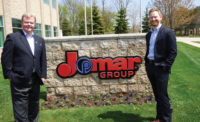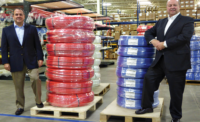Jim Allen, president and CEO of Sloan Valve Co., recently sat down with pme to discuss the Chicago-based manufacturer’s enhanced role with the city’s iconic baseball team, the Cubs, the growing desire for beauty in commercial plumbing products and other issues in the plumbing industry.
pme:What does the relationship with the Chicago Cubs mean to the company and how did this opportunity/decision come about?
Jim Allen: It’s important to understand that we’re a Chicago brand. My great grandfather, William Elvis Sloan, founded the company in 1906 and the following year the Chicago Cubs went to the World Series and won. Then they repeated in 1908 and haven’t won one since. We are a Chicago-established company. That’s where our roots are.
There is a natural feel to partnering with another Chicago icon such as the Cubs. Sports marketing is a new arena for us to get involved in. We have an unofficial sports marketing initiative in which we invite customers to ball games and do those sorts of things with the season tickets that we have. But, this is to a new level for us and we are very excited about it.
The reason why we did this is because the opportunity came to us through our relationship with the Chicago Cubs. We’ve been installed in Wrigley Field since it was built in 1914, so we have a longstanding relationship. We knew the naming rights deal (of the Cubs’ spring training facility in Mesa, Ariz.) was there and that the Cubs were looking for legacy partners. The idea behind the legacy partnership with the Cubs is helping the organization build a winning team. That’s the nature of the legacy partnership. With the help of these legacy sponsors that helps put a winning product on the field.
Also, we’re a national brand. This is much bigger than just Chicago and just the Cubs. The naming rights to the ballpark in Arizona is a unique play for a company such as ours. The reality is that ballparks are great showcases for Sloan products.
pme:How has the commercial bathroom product landscape changed in recent times? Are you noticing any distinct trends/wants/needs from building owners, engineers and designers?
JA: The overwhelming trend is efficiency without question. Owners, engineers and designers want products that are efficient that don’t sacrifice performance. I think the industry has rallied to that trend across the board. Sloan is very proud of our leadership in that market.
As far was water efficiency, I think the continuing trend in that landscape is doing more with less without sacrificing hygiene, cleanliness or performance and answering that need of the engineer, owner and designer with unique products.
Another trend in the commercial market is the larger focus or emphasis on design and ascetics. Everyone wants something as beautiful as an iPhone that you can hammer nails with in the commercial environment. That’s what we challenge ourselves with; coming up with solutions that are elegant from an ascetic standpoint, but also meet that Sloan tradition of quality and durability.
pme:How does Sloan balance the demands of water efficiency with high-performance products?
JA: We have an ongoing discussion about this very question: How low can you go [gallons per flush]? Because we can design and manufacture a product that flushes a fraction of a gallon does that mean we should? In other words, there is an existing, installed base of buildings out there that if you try retrofit high-efficiency plumbing into an existing facility that maybe does not have good behind-the-wall systems, it is a recipe for disaster.
We always are conservative from the standpoint that the products we offer the market we realize we won’t have total control on where the wind up. We want Sloan to be able to perform in any environment that it can. As we try and get that nexus of efficiency and performance, that usually is the result of a lot of testing. We don’t offer products to the marketplace that we don’t thoroughly field-trial or that we don’t thoroughly test within our own operations here. The trend, obviously, is for using less water. So the obligation to the manufacturer is to come up with some unique ways to accomplish that without sacrificing performance.
Sloan is in a unique position to do that given our 100-year history of working within commercial bathrooms. We have tremendous experience with making that work, innovating and developing new systems and technologies to help our customers achieve those goals.
pme:How does durability fit into the product design equation?
JA: Our products are largely made in the United States. We use high-quality gauge materials to make our products very robust. In our design process we use what’s called DFMEA or (design failure mode and effect analysis) to understand the interaction of design with application and root out issues early in the design process, not just in testing. Part of that DFMEA analysis is the durability under various scenarios.
pme: How has Sloan advanced its relationship with the engineering and design community?
JA: They have always been a major focus for us. We have developed tools on our website such as a product configurator and a visual specification builder, information that our reps can communicate to the engineers. Basically, to get the engineer the information they need to make the product selection choice easier. Anytime you’re dealing with an engineer, they have a set of goals they’re trying to accomplish in their design. Our job is to give them the solutions to those problems in a format that is easy for them to incorporate into their design.
We’ve engaged a company called ATS, a national spec builder that allows engineers access to BIM drawings as well as 3D CAD drawings and all kinds of information to be able to build a spec in a virtual environment with ease. The idea is to make it easier for the engineer.
pme: What has been Sloan’s biggest product/technology innovation recently?
JA: Given our focus on water efficiency, product categories such as waterfree urinals and our BASYS faucet category are big. That is a new platform of faucets for us. It allows the designer to have the features that he/she wants while delivering the efficiencies they want.
One product that will be coming out soon is called the AER-DEC Integrated Sink. It’ll be a revolutionary product. It’s a sink with a combination of soap, water and air drying. Typically, you have an air dryer outside the sink system that creates a hazard situation with water dripping or issues such as a man who might dry his hands on his pants. Hygiene elements to us are really important. This product is on our upscale, premium level. All three elements are right next to each other where the user goes from soap to water to the dryer in one motion. It’s also a very traffic-friendly product.
We want to improve the customer’s experience in the restroom. This is what designers and architects are looking for.
pme:What makes Sloan stand out as a company?
JA: We are an innovative company. We spend a lot of time and effort into research and development, and in product design. We don’t sit still and wait for concepts to come to us. We are actively engaged in the new product development process which is ongoing. Sloan is a leader and people expect us to continue advancing in new ways and new technologies.
We make a point of standing behind our product. We stand behind everything we make and we’re a customer-focused company.
pme:What would your advice be to a specifying engineer?
JA: What we find is that most of the specifying engineers we deal with really do take the time to become educated on trends and new technologies. A lot of the obligation is on the manufacturer to tell the story and back up the stories related to new products so the engineer has the information needed to make decisions on products.
I would say read the trade publications, keep your radar open for new technologies and products, and ask questions of the manufacturer. Challenge the manufacturer on their claims, especially when they are making bold claims on water efficiency.
What we are obligated to do as plumbing manufacturers and their obligated to do as engineers is to protect public health. To that end it’s important they challenge claims and look for empirical studies and data that supports manufacturers’ claims. It makes the manufacturer better and makes their position in the value chain better. I think it makes us all better with what we’re charged to do and that’s to protect the public health.







